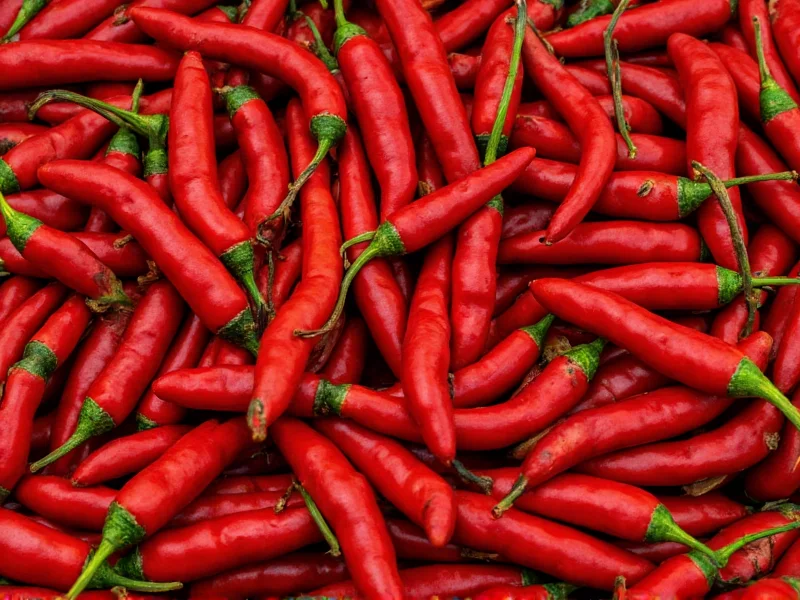Ancho chiles represent one of the most versatile and widely used dried peppers in Mexican cuisine, yet many home cooks wonder about their heat level when planning recipes. Understanding the precise spiciness of ancho chiles helps cooks balance flavors effectively without overwhelming a dish with unexpected heat.
What Exactly Are Ancho Chiles?
Ancho chiles are simply dried poblano peppers. When fresh poblanos ripen to a deep red color and undergo the drying process, they transform into anchos, developing a more complex flavor profile while maintaining their characteristic mild heat. The name "ancho" means "wide" in Spanish, referring to the pepper's broad, flat shape.
Understanding Ancho Chile Heat Level
The heat measurement of chili peppers occurs on the Scoville Scale, which quantifies capsaicin concentration. Ancho chiles sit at the lower end of this spectrum:
| Pepper Type | Scoville Heat Units | Heat Comparison |
|---|---|---|
| Ancho Chile | 1,000-2,000 SHU | Mild, earthy warmth |
| Jalapeño | 2,500-8,000 SHU | 2-4 times hotter than ancho |
| Serrano | 10,000-23,000 SHU | 5-10 times hotter than ancho |
| Habanero | 100,000-350,000 SHU | 50-175 times hotter than ancho |
This moderate heat level makes ancho chiles accessible to most palates, including those with lower spice tolerance. The heat primarily registers as a gentle warmth at the back of the throat rather than an immediate burning sensation.
Flavor Profile Beyond Heat
While many focus solely on spiciness, ancho chiles offer a complex flavor profile that makes them valuable in cooking:
- Earthy notes with subtle tobacco undertones
- Fruity sweetness reminiscent of dried fruits
- Chocolate and coffee hints in properly aged anchos
- Smoky depth when toasted before use
Chefs prize ancho chiles specifically for this balance—enough heat to provide dimension without dominating other flavors. The drying process concentrates sugars while mellowing the raw heat of fresh poblanos.
Culinary Applications of Ancho Chiles
The moderate spiciness of ancho chiles makes them ideal for various cooking techniques:
Dry Rubs and Spice Blends
Ancho powder features prominently in chili powders and taco seasonings because it provides color and flavor without excessive heat. When making your own blend, use ancho as the base pepper and add hotter varieties like cayenne only for additional kick.
Mojo and Adobo Sauces
Rehydrated ancho chiles form the foundation of many Mexican sauces. Their mild heat allows other ingredients like garlic, cumin, and oregano to shine through. For authentic mole poblano, anchos combine with chocolate and spices to create a complex sauce where heat plays a supporting role.
Meat and Vegetable Dishes
Whole or ground ancho chiles enhance stews, braises, and roasted vegetables. Their gentle warmth penetrates ingredients without overwhelming delicate flavors—a quality that makes them perfect for dishes served to children or spice-sensitive guests.
Factors Affecting Ancho Chile Heat
Several variables influence the actual spiciness you'll experience:
- Growing conditions—Sun exposure and soil composition affect capsaicin production
- Storage duration—Heat diminishes over time; older anchos taste milder
- Preparation method—Removing seeds and membranes reduces heat significantly
- Individual sensitivity—Personal tolerance varies considerably
When substituting ancho chiles in recipes, consider guajillo peppers for similar mild heat with more tanginess, or mulato chiles for deeper chocolate notes with comparable spiciness.
Practical Tips for Cooking with Ancho Chiles
Maximize flavor while controlling heat with these techniques:
- Toast before use—Lightly heat whole dried anchos in a dry skillet for 20-30 seconds per side to enhance flavor without increasing heat
- Remove seeds and veins—These contain most capsaicin; discard them for the mildest preparation
- Rehydrate properly—Soak in hot water (not boiling) for 15-20 minutes to preserve flavor compounds
- Balance with acidity—A splash of lime juice can counteract any unexpected heat
Understanding that ancho chiles deliver mild spiciness with complex flavor helps cooks use them more effectively. Their position on the lower end of the heat spectrum makes them an excellent entry point for those exploring Mexican cuisine or developing spice tolerance.
Frequently Asked Questions
How does ancho chile heat compare to chipotle peppers?
Ancho chiles are significantly milder than chipotle peppers. While anchos measure 1,000-2,000 Scoville units, chipotles (smoked jalapeños) range from 2,500-8,000 units. Chipotles deliver both more heat and a pronounced smoky flavor compared to the earthy, fruity notes of anchos.
Can I substitute ancho chile powder for regular chili powder?
Yes, but with flavor adjustments. Ancho chile powder provides milder heat and more complex flavor than standard chili powder (which typically contains multiple peppers plus cumin and garlic). Use 1:1 substitution but consider adding 1/4 teaspoon cumin per tablespoon of ancho powder to approximate traditional chili powder's flavor profile.
Why do some ancho chiles taste hotter than others?
Natural variation occurs due to growing conditions, with sunnier, drier climates producing hotter peppers. Age also affects heat—freshly dried anchos maintain more capsaicin than older stock. Additionally, improper storage (exposure to heat or moisture) can concentrate capsaicin in certain areas of the pepper.
Are ancho chiles safe for children to eat?
Yes, ancho chiles' mild heat level (1,000-2,000 SHU) makes them generally safe for children. For comparison, black pepper measures about 1,000 SHU. When preparing dishes with anchos for children, remove seeds and membranes to further reduce heat, and start with small quantities to assess tolerance.
What's the difference between ancho and mulato chiles?
Both come from dried poblanos, but differ in ripeness at harvest. Anchos come from fully red-ripe poblanos, while mulatos come from overripe, nearly black poblanos. Mulatos have deeper chocolate and coffee notes with slightly more heat (2,500-3,000 SHU) compared to anchos' fruitier profile and milder heat (1,000-2,000 SHU).











 浙公网安备
33010002000092号
浙公网安备
33010002000092号 浙B2-20120091-4
浙B2-20120091-4